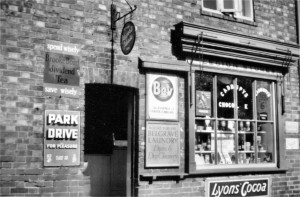A conversation at work recently reminded me how differently we treat food these days, compared to fifty, or so, years ago.
Someone was sniffing and scrutinising the milk, prior to making a hot drink, and decided it was time to part company, because the milk wasn’t quite as fresh and youthful as it had been (I know the feeling) and it reminded me of how we stored and used milk before we had fridges.
(Gripping stuff, are you sure you don’t have anything better to do; clip your toenails, put the cat out?)
When I started to think back I was quite surprised at how much our shopping, cooking and eating habits have changed since the 1950s. In fact before long I might also use it as an excuse to blather on about the local stores that we had before supermarkets arrived on the scene.
(Incidentally, why is the cat on fire?)
Anyway, back to milk. Before the widespread appearance of supermarkets in the late 1950s and early 1960s, most people had fresh milk delivered daily and, without a fridge, it was kept in the coolest place in the kitchen, pantry or cellar. We sometimes also had bottles of sterilized milk, which kept longer unopened, but didn’t taste as good as the fresh stuff.
Fridges didn’t become very widespread in British homes until the 1960s and 70s, so milk was normally used the day it was delivered, but if it happened to hang around a little longer, particularly in hot weather, it would start turn a little too sour for regular use.
Now I don’t know about most families at the time, but ours didn’t often throw it out. We kept it in a cool place until it had thickened up; I think Mum used to mix something like a little lemon juice in to curdle it. Then it was poured (well, perhaps glopped would be a better description) onto a piece of muslin, which was gathered up with the ends tied together, then hung over a bowl to allow the liquid to drain off. Once it stopped dripping it had a consistency between cream cheese and cottage cheese and was ready for use. At some point it was mixed with salt to improve the flavour and keep it fresh for longer, but I can’t remember if the salt was added at the end or before it was strained through the muslin.
The storage and shelf life of fresh food has altered a lot; food didn’t have ‘sell by’ or ‘use by’ dates until the 1970s, and then it was a bit sporadic. We used to pick up and examine our food; if it smelled okay and there are no unsightly slimy bits, then we would just eat it. If the cheese had a bit of mould growing on the outside, we would cut a layer off. If the bread was getting stale it was made into bread pudding, stale cake was made into trifle and so on.
I’m loath to trot out the customary ‘it never did me any harm’, but I do think we waste too much food. It would be more practical to inspect our food carefully and cook it thoroughly and with care, instead of just chucking it out for what sometimes seems to be an arbitrary date that depends on too many variables to be completely accurate.
We used to store some fruit and vegetables for months. Onions, for example, were cleaned up and kept dry, tied together and hung from hooks in the shed. When we wanted one, it was pulled or snipped one from the bunch and with luck they would keep all winter, or even longer.
Apples, as long as they were fresh and undamaged, would keep for months stored in a cool, dark place with a good air circulation. Similarly, we stored clean, dry, undamaged potatoes for a long time in paper or hessian sacks kept in cool, dry and dark conditions.
Anyway, you get the idea, before this turns into an episode of Gardener’s Question Time.
Another pre-fridge piece of equipment we used was a meat safe fixed to the wall outside, on the north facing side of the house, to keep it cool and out of the sun. The meat safe was a small metal cupboard with mesh covered holes to allow air circulation, but keep flies and vermin out, and we kept dairy produce, joints of meat, sausages, dripping and potted meat in it, particularly in cooler months.

In an old village shop we once managed, we had a cool and damp cellar that often served as a fridge. Mum made a trifle for a party and stored it in the cellar; it may have been for my birthday, but I don’t remember that. What I do remember is that when she went down to collect the trifle, there was a large frog sitting, apparently quite comfortably, in the centre. I don’t think we ate the trifle, although Dad wasn’t so fussy and probably scooped out the contaminated bits and scoffed the rest.
Since I first owned a fridge, I don’t ever remember finding a frog in any desserts. Although I do know how to tell if there are elephants in the refrigerator…
More on Legion Stores …cut into chunks, weighed and wrapped
